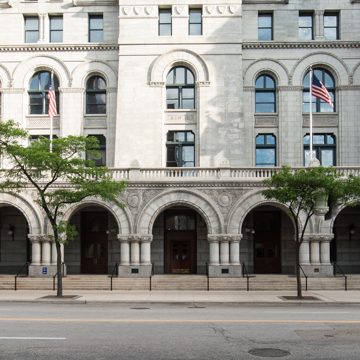This imposing Romanesque Revival fortress reflects the influence of Boston architect H. H. Richardson. His widely admired design for the Allegheny County Courthouse (1883–1888) in Pittsburgh inspired many copies in the 1890s, among them this federal building, which originally included a ground-floor post office. Edbrooke designed this and similar post offices in St. Paul, Minnesota, and Washington, D.C. The building’s thick load-bearing walls are made of Maine granite and embellished with carved floral decorations and zigzag motifs. Gargoyles leer from the eaves at passersby. Standing guard above them, a square, central turreted tower rises to a slate-covered spire.
Inside, visitors step into one of the Midwest’s best institutional Victorian-era interiors. Edbrooke organized the floor plan around a spectacular central atrium, a feature in his other federal buildings. The five-story space is bathed in sunlight through a massive skylight. The atrium additionally ventilates the building’s interior lobbies and corridors. These are trimmed with multicolored marble paneling, wainscoting, and door framing, and with wood-paneled and colorful mosaic ceilings.











